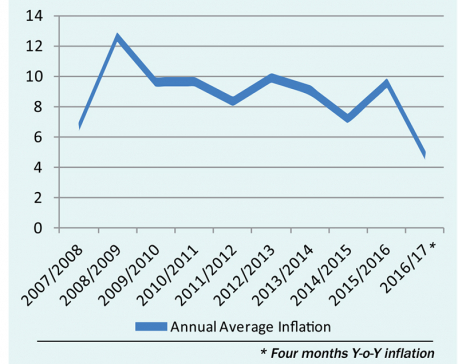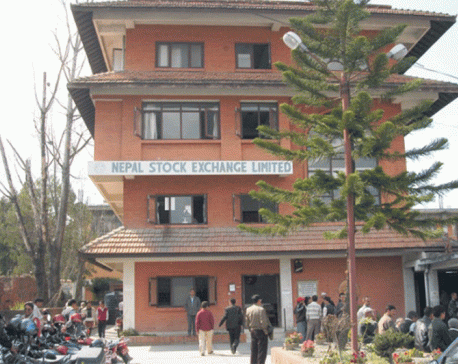
OR
Current Macroeconomic Situation Report
Inflation falls to 12-year low of 4.5 percent
Published On: August 22, 2017 02:39 AM NPT By: Republica | @RepublicaNepal
KATHMANDU, Aug 21: Annual average inflation fell to 4.5 percent in the last Fiscal Year 2016/17.
According to the Nepal Rastra Bank (NRB), the pace of price rise nearly halved in the last fiscal year from a near double-digit level in 2015/16.
The inflation, measured in consumer price index, is the lowest in the past 12 years. The last time the annual average inflation fell to this level was in fiscal year 2004/05 when price had grown by 4.5 percent.
With the inflation moderating to 4.5 percent, the central bank has succeeded in taming price hike below its target level for the third time since it started issuing monetary policy in 2002/003. The NRB had announced that it would contain inflation at 7.5 percent in 2016/17. In most of the fiscal years, the inflation has breached the central bank's target. The only two other occasions when the actual inflation remained lower than the central bank's target was in 2003/04 and 2006/07.
The rapid fall in inflation is attributed mainly to higher base price of the earlier fiscal year when inflation was at near double-digit level amid unofficial blockade imposed by India and tarai turmoil which had disrupted supply system of the country.
“The higher base price of the preceding year, improved supply situation and lower global prices, including that of India, helped inflation ease in the review year,” read the annual Macroeconomic and Financial Situation Report of the central bank released on Monday.
The decline in prices of ghee and oil, pulses and legumes, vegetables, and transportation, among others, were mainly responsible for drop in overall consumer price, according to the central bank's periodic report.
While the average food inflation eased to 1.9 percent in 2016/17 down from 10.9 percent in the earlier fiscal year, non-food inflation moderated to 6.5 percent in the review year from 9.2 percent a year ago. The decline in prices of ghee and oil (6 percent), pulses and legumes (5.5 percent) and vegetable (2.5 percent) drove down overall food inflation in the review year.
The hilly region witnessed a relatively higher annual average inflation of 6.4 percent followed by tarai region (4.4 percent), hilly region (4.1 percent) and the Kathmandu Valley (3.1 percent).
The central bank is, however, worried that the recent floods and landslides could put upward pressure on inflation.
“The recent floods and landslides can create upside risks to inflation,” read the report. “However, such risks will be temporary,” it added.
You May Like This

Inflation cools down to 3.8 percent
KATHMANDU, Jan 17: Inflation significantly decelerated to 3.8 percent in mid-December last year from 11.6 percent in the corresponding period of... Read More...

Inflation slows to 4.8 percent
KATHMANDU, Dec 16: Following a ‘spiralling rise in prices’ in the last fiscal year due to prolonged tarai unrest and unofficial... Read More...

Circuit breaker clamped after Nepse Index falls over 3 percent
KATHMANDU, Nov 28: Nepal Stock Exchange (Nepse) on Monday clamped circuit breaker after the Nepse Index witnessed a fall of... Read More...





Just In
- MoHP cautions docs working in govt hospitals not to work in private ones
- Over 400,000 tourists visited Mustang by road last year
- 19 hydropower projects to be showcased at investment summit
- Global oil and gold prices surge as Israel retaliates against Iran
- Sajha Yatayat cancels CEO appointment process for lack of candidates
- Govt padlocks Nepal Scouts’ property illegally occupied by NC lawmaker Deepak Khadka
- FWEAN meets with President Paudel to solicit support for women entrepreneurship
- Koshi provincial assembly passes resolution motion calling for special session by majority votes






_20220508065243.jpg)






Leave A Comment